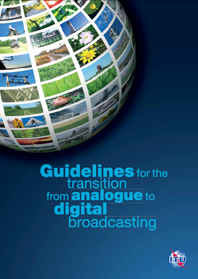
Contact us: info@tvabsat.com
The Switchover is 'a transition from analogue to digital broadcasting' to be implemented in accordance with Guidelines issued by the ITU. The ITU is a specialised agency of the United Nations.
The full Guidelines are available to download as a PDF here

The Guidelines include regulations (ITU-R) which entail; Radio Regulations (RR), the Table of Frequency Allocations (Region 1), provisions of the World Radiocommunications Conference (WRC-07), the Geneva Agreement 2006 (GE06) and, the World Telecommunication Development Conference 2010 (WTDC-10). The GE06 was signed by more than 100 countries including all African countries within the TVabsat transmission footprint.
The Guidelines include Plans giving each country guaranteed access to the spectrum for the operation of certain services; in particular for DTT and MTV. These include 'plans for the use of African Administrations.' Regulators are charged to 'formulate their DTT policy and regulations to be compliant with these ITU regulations.' The Guidelines are intended for use in Africa and constitute a framework to help countries plan and coordinate the steps for the transition.
Governments, as signatories to the GE06, are committed to individually putting in place legislation as necessary to ensure compliance with the regulations. The most important of these for the TVabsat project is that each Government sets a mandatory date for analogue switch-off (ASO).
An ASO process is a Government-led process. The analogue switch-off on the 17th of June 2015 is the day when all analogue TV broadcasting in the TVabsat area will stop. Prior to the ASO the Guidelines recommend that Governments consider a period of 'simulcasting' to provide viewers a period of time to switch to another/digital platform. In that period of simulcasting both the existing analogue services and the new digital services are broadcast. This may imply additional network costs with hardly any or limited added value for the individual broadcaster involved.
The impact of the ASO should not be underestimated. The number of terrestrial viewers may be limited in absolute numbers but the relative proportion might be very high. This might be the case for several African countries. In addition, the alternative providers may be limited too. For example in most African countries only one alternative is available: a pay-tv satellite service (provided by two key players DSTV in East / Anglophone Africa and Canal+ in West / Francophone).
The ITU advises that as this is a Government-led process, this risk of disenfranchising viewers is politically a sensitive topic and should be prepared carefully. Especially determining the various viewer groups and the number of affected viewers is critical. TVabsat will be the exception to this general rule offering Broadcasters the opportunity to launch free-to-air programming on a genuinely universal basis.
The ASO can be on a Nationwide or a phased basis with Broadcasters having to evaluate the logistical and financial implications involved in either case. TVabsat has been mindful of these issues in developing the most user friendly business model. Working closely with individual Broadcasters TVabsat will simulcast introductory programming on their analogue band giving their viewers the information and time that they need to ensure a seamless switch-over schedule.